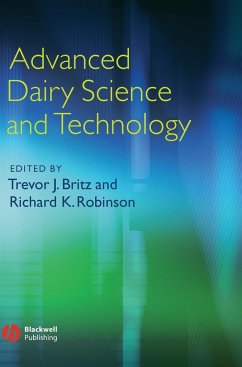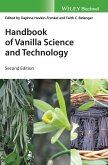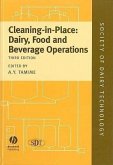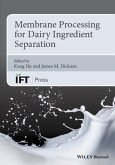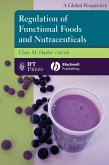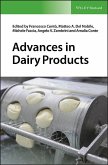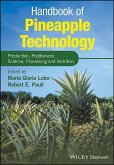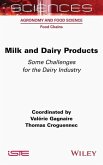- Gebundenes Buch
- Merkliste
- Auf die Merkliste
- Bewerten Bewerten
- Teilen
- Produkt teilen
- Produkterinnerung
- Produkterinnerung
This important and comprehensive book covers, in depth, the most important recent advances in dairy technology. Providing core commercially important information for the dairy industry, the editors, both internationally known for their work in this area, have drawn together an impressive and authoritative list of contributing authors. Topics covered include: heat treatment, membrane processing, hygiene by design, application of HACCP, automation, safety and quality, modern laboratory practices and analysis, and environmental aspects. This book is an essential purchase for all dairy…mehr
Andere Kunden interessierten sich auch für
![Handbook of Vanilla Science and Technology Handbook of Vanilla Science and Technology]() Handbook of Vanilla Science and Technology215,99 €
Handbook of Vanilla Science and Technology215,99 €![Cleaning-In-Place Cleaning-In-Place]() Cleaning-In-Place294,99 €
Cleaning-In-Place294,99 €![Membrane Processing for Dairy Ingredient Separation Membrane Processing for Dairy Ingredient Separation]() Membrane Processing for Dairy Ingredient Separation185,99 €
Membrane Processing for Dairy Ingredient Separation185,99 €![Regulation of Functional Foods and Nutraceuticals Regulation of Functional Foods and Nutraceuticals]() Hasler Clare MRegulation of Functional Foods and Nutraceuticals300,99 €
Hasler Clare MRegulation of Functional Foods and Nutraceuticals300,99 €![Advances in Dairy Products Advances in Dairy Products]() Advances in Dairy Products185,99 €
Advances in Dairy Products185,99 €![Handbook of Pineapple Technology Handbook of Pineapple Technology]() Handbook of Pineapple Technology205,99 €
Handbook of Pineapple Technology205,99 €![Milk and Dairy Products: Some Challenges for the Dairy Industry Milk and Dairy Products: Some Challenges for the Dairy Industry]() Milk and Dairy Products: Some Challenges for the Dairy Industry159,99 €
Milk and Dairy Products: Some Challenges for the Dairy Industry159,99 €-
-
-
This important and comprehensive book covers, in depth, the most important recent advances in dairy technology. Providing core commercially important information for the dairy industry, the editors, both internationally known for their work in this area, have drawn together an impressive and authoritative list of contributing authors. Topics covered include: heat treatment, membrane processing, hygiene by design, application of HACCP, automation, safety and quality, modern laboratory practices and analysis, and environmental aspects. This book is an essential purchase for all dairy technologists worldwide, whether in academic research and teaching, or within food companies.
Produktdetails
- Produktdetails
- Verlag: Wiley
- Seitenzahl: 314
- Erscheinungstermin: 26. Februar 2008
- Englisch
- Abmessung: 250mm x 175mm x 21mm
- Gewicht: 726g
- ISBN-13: 9781405136181
- ISBN-10: 1405136189
- Artikelnr.: 22995938
- Herstellerkennzeichnung
- Libri GmbH
- Europaallee 1
- 36244 Bad Hersfeld
- gpsr@libri.de
- Verlag: Wiley
- Seitenzahl: 314
- Erscheinungstermin: 26. Februar 2008
- Englisch
- Abmessung: 250mm x 175mm x 21mm
- Gewicht: 726g
- ISBN-13: 9781405136181
- ISBN-10: 1405136189
- Artikelnr.: 22995938
- Herstellerkennzeichnung
- Libri GmbH
- Europaallee 1
- 36244 Bad Hersfeld
- gpsr@libri.de
Dr Richard Robinson, UK Professor Trevor Britz, University of Stellenbosch, South Africa
List of Contributors x
Preface xi
1 Thermapl Processing of Milk 1
Peter de Jong
1.1 Introduction 2
1.1.1 Background 2
1.1.2 Outline 2
1.2 Heat-induced changes of milk 3
1.2.1 Heat-induced reactions in milk - bulk reactions 3
1.2.2 Heat-induced reactions in milk - surface reactions 7
1.2.3 Reaction engineering approach 7
1.3 Processes 9
1.3.1 Equipment 9
1.3.2 Classification of heating processes 11
1.3.3 Advanced processes 13
1.4 Operational considerations and limitations 15
1.4.1 Flow characteristics 15
1.4.2 Protein and mineral fouling 16
1.4.3 Adherence and growth of microorganisms 19
1.5 Optimization 22
1.5.1 Introduction 22
1.5.2 Approach 23
1.5.3 Case study: pasteurization 25
1.6 Conclusions and future trends 28
1.6.1 Longer operating times 28
1.6.2 Integrating technologies 29
1.6.3 Model-based control of heating processes 30
References 31
2 Applications of Membrane Separation 35
Athanasios Goulas and Alistair S. Grandison
2.1 Introduction 36
2.2 Transport theory of membrane separation processes 37
2.2.1 Classification of processes 37
2.2.2 Concentration polarization and fouling 42
2.2.3 Physical parameters of membrane processes 45
2.2.4 Diafiltration 46
2.2.5 Parameters affecting flux and rejection 47
2.3 Membrane classification, production methods and characterization 48
2.4 Modules and modes of operation of pressure-driven membrane filtration
processes 50
2.5 Hygiene and cleaning 54
2.6 Composition and properties of dairy fluids for membrane processing 55
2.7 Applications of membranes in the dairy industry 57
2.7.1 Reverse osmosis 57
2.7.2 Nanofiltration 58
2.7.3 Ultrafiltration 58
2.7.4 Microfiltration 61
2.7.5 Electrodialysis and electro-membrane filtration 62
2.7.6 Membrane bioreactors 63
2.7.7 Selective separations of dairy-derived carbohydrates by
nanofiltration 69
2.8 Future developments 70
References 71
3 Hygiene by Design 75
J. Ferdie Mostert and Elna M. Buys
3.1 Introduction 76
3.2 Maintaining a clean working environment in dairy plant operations 77
3.2.1 Introduction 77
3.2.2 Regulations 77
3.2.3 Sources of contamination 79
3.2.4 Waste and effluent management 90
3.3 Clean room design 91
3.3.1 Hygienic plant design 91
3.3.2 Dealing with airborne contamination 92
3.3.3 Hygienic equipment design 94
3.4 Clean room operations 96
3.4.1 Objectives of plant cleaning 96
3.4.2 Cleaning operations 97
3.4.3 Sanitization and sterilization 105
3.5 Dealing with biofilms 107
3.5.1 Biofilm formation 108
3.5.2 Detection of biofilms 109
3.5.3 Biofilm control/removal 110
3.6 Monitoring dairy plant hygiene 111
3.6.1 Air quality 111
3.6.2 Cleanliness of sanitized surfaces 112
3.6.3 Water quality 114
References 114
4 Automation in the Dairy Industry 121
Evaggelos Doxanakis and Asterios Kefalas
4.1 Introduction 122
4.2 A brief history of automation in the dairy 122
4.3 Factors contributing to automation 124
4.3.1 Six factors driving automation 124
4.4 Benefits of automation 125
4.5 Conceptual framework of an automated system 125
4.5.1 What is a system? 125
4.5.2 Objects 126
4.6 Stages in automation in the dairy 129
4.6.1 First wave: mechanization 129
4.6.2 Second wave: automation 130
4.6.3 Third wave: cybernation 135
4.7 Lotus integrated safety system - a case study in the dairy industry 143
4.7.1 Summary 146
4.8 Automation at the enterprise level 147
4.8.1 Logistics in dairy: how it helps 149
4.8.2 Enterprise Resource Planning 150
4.9 Conclusions 152
References 152
5 Safety and Quality of Dairy Products 153
Peter J. Jooste and Lucia E.C.M. Anelich
5.1 Introduction 154
5.2 Pathogens of special relevance 155
5.2.1 Introduction 155
5.2.2 Prions 156
5.2.3 Viruses 157
5.2.4 Rickettsiae 158
5.2.5 Protozoa 158
5.2.6 Bacteria 160
5.3 Chemical hazards 168
5.3.1 Mycotoxins 169
5.3.2 Antimicrobials 170
5.3.3 Allergens 171
5.3.4 Industrial and environmental contaminants 171
5.3.5 Procedures to minimize risk of feed and milk contamination 173
5.4 Physical hazards 174
5.5 Traceability of ingredients 176
References 178
6 Modern Laboratory Practices - Analysis of Dairy Products 183
Thomas Bintsis, Apostolos S. Angelidis and Lefki Psoni
6.1 Introduction 184
6.2 Laboratory quality assurance 184
6.2.1 Accreditation of laboratories 185
6.2.2 Validation of analytical methods 187
6.2.3 Quantifying uncertainty, calibration and traceability 187
6.2.4 Quality aspects of microbiological media 188
6.2.5 Laboratory safety 189
6.3 Sampling 190
6.3.1 Sample collection 191
6.3.2 Sampling report 192
6.4 Chemical analyses 192
6.4.1 Fat content 193
6.4.2 Protein content 193
6.4.3 Total solids 196
6.4.4 Ash content 196
6.4.5 Lactose content 196
6.4.6 Urea determination 197
6.4.7 Salt content 197
6.4.8 Routine instrumental methods 197
6.5 Detection of antibiotic residues 198
6.6 Detection of adulteration in dairy products 203
6.7 Detection of abnormal milk 211
6.8 Microbiological methods 212
6.8.1 Standard plate count 212
6.8.2 Direct microscopic count 214
6.8.3 Direct epifluorescent technique 214
6.8.4 Spiral plate counting 214
6.8.5 Bactoscan 215
6.8.6 Dye reduction tests 215
6.8.7 Determination of pyruvate or ammonia 216
6.8.8 Contaminating microorganisms 216
6.8.9 Thermoduric bacteria 217
6.8.10 Coliforms and Enterobacteriaceae 217
6.8.11 Enterococcus spp. 218
6.8.12 Yeasts and moulds 219
6.8.13 Specific pathogenic bacteria 219
6.9 Rapid microbiological methods 221
6.9.1 Antibody-based methods 222
6.9.2 Nucleic-acid-based methods 227
6.9.3 Membranes 232
6.9.4 Impedance 232
6.9.5 Biochemical enzymatic methods and diagnostic kits 233
6.9.6 ATP bioluminence 234
6.10 Sensory evaluation of dairy products 234
Acknowledgements 238
References 238
7 Dealing with Environmental Issues 262
Trevor J. Britz, Corné Lamprecht and Gunnar O. Sigge
7.1 Introduction 263
7.2 Dairy wastewaters: sources and composition 263
7.2.1 General composition of dairy wastewaters 263
7.2.2 Milk reception and storage areas 264
7.2.3 Heat processing of milk 265
7.2.4 Production of evaporated milk products 265
7.2.5 Production of powdered dairy products 265
7.2.6 Cheese manufacture 266
7.2.7 Butter manufacture 266
7.2.8 Yoghurt manufacture 266
7.3 Treatment options 267
7.3.1 Direct discharge to a sewage-treatment works 267
7.3.2 Pre-treatment options 268
7.3.3 Aerobic biological systems 271
7.3.4 Anaerobic biological systems 280
7.3.5 Chemical systems 286
7.4 Conclusions 287
References 288
Index 294
Preface xi
1 Thermapl Processing of Milk 1
Peter de Jong
1.1 Introduction 2
1.1.1 Background 2
1.1.2 Outline 2
1.2 Heat-induced changes of milk 3
1.2.1 Heat-induced reactions in milk - bulk reactions 3
1.2.2 Heat-induced reactions in milk - surface reactions 7
1.2.3 Reaction engineering approach 7
1.3 Processes 9
1.3.1 Equipment 9
1.3.2 Classification of heating processes 11
1.3.3 Advanced processes 13
1.4 Operational considerations and limitations 15
1.4.1 Flow characteristics 15
1.4.2 Protein and mineral fouling 16
1.4.3 Adherence and growth of microorganisms 19
1.5 Optimization 22
1.5.1 Introduction 22
1.5.2 Approach 23
1.5.3 Case study: pasteurization 25
1.6 Conclusions and future trends 28
1.6.1 Longer operating times 28
1.6.2 Integrating technologies 29
1.6.3 Model-based control of heating processes 30
References 31
2 Applications of Membrane Separation 35
Athanasios Goulas and Alistair S. Grandison
2.1 Introduction 36
2.2 Transport theory of membrane separation processes 37
2.2.1 Classification of processes 37
2.2.2 Concentration polarization and fouling 42
2.2.3 Physical parameters of membrane processes 45
2.2.4 Diafiltration 46
2.2.5 Parameters affecting flux and rejection 47
2.3 Membrane classification, production methods and characterization 48
2.4 Modules and modes of operation of pressure-driven membrane filtration
processes 50
2.5 Hygiene and cleaning 54
2.6 Composition and properties of dairy fluids for membrane processing 55
2.7 Applications of membranes in the dairy industry 57
2.7.1 Reverse osmosis 57
2.7.2 Nanofiltration 58
2.7.3 Ultrafiltration 58
2.7.4 Microfiltration 61
2.7.5 Electrodialysis and electro-membrane filtration 62
2.7.6 Membrane bioreactors 63
2.7.7 Selective separations of dairy-derived carbohydrates by
nanofiltration 69
2.8 Future developments 70
References 71
3 Hygiene by Design 75
J. Ferdie Mostert and Elna M. Buys
3.1 Introduction 76
3.2 Maintaining a clean working environment in dairy plant operations 77
3.2.1 Introduction 77
3.2.2 Regulations 77
3.2.3 Sources of contamination 79
3.2.4 Waste and effluent management 90
3.3 Clean room design 91
3.3.1 Hygienic plant design 91
3.3.2 Dealing with airborne contamination 92
3.3.3 Hygienic equipment design 94
3.4 Clean room operations 96
3.4.1 Objectives of plant cleaning 96
3.4.2 Cleaning operations 97
3.4.3 Sanitization and sterilization 105
3.5 Dealing with biofilms 107
3.5.1 Biofilm formation 108
3.5.2 Detection of biofilms 109
3.5.3 Biofilm control/removal 110
3.6 Monitoring dairy plant hygiene 111
3.6.1 Air quality 111
3.6.2 Cleanliness of sanitized surfaces 112
3.6.3 Water quality 114
References 114
4 Automation in the Dairy Industry 121
Evaggelos Doxanakis and Asterios Kefalas
4.1 Introduction 122
4.2 A brief history of automation in the dairy 122
4.3 Factors contributing to automation 124
4.3.1 Six factors driving automation 124
4.4 Benefits of automation 125
4.5 Conceptual framework of an automated system 125
4.5.1 What is a system? 125
4.5.2 Objects 126
4.6 Stages in automation in the dairy 129
4.6.1 First wave: mechanization 129
4.6.2 Second wave: automation 130
4.6.3 Third wave: cybernation 135
4.7 Lotus integrated safety system - a case study in the dairy industry 143
4.7.1 Summary 146
4.8 Automation at the enterprise level 147
4.8.1 Logistics in dairy: how it helps 149
4.8.2 Enterprise Resource Planning 150
4.9 Conclusions 152
References 152
5 Safety and Quality of Dairy Products 153
Peter J. Jooste and Lucia E.C.M. Anelich
5.1 Introduction 154
5.2 Pathogens of special relevance 155
5.2.1 Introduction 155
5.2.2 Prions 156
5.2.3 Viruses 157
5.2.4 Rickettsiae 158
5.2.5 Protozoa 158
5.2.6 Bacteria 160
5.3 Chemical hazards 168
5.3.1 Mycotoxins 169
5.3.2 Antimicrobials 170
5.3.3 Allergens 171
5.3.4 Industrial and environmental contaminants 171
5.3.5 Procedures to minimize risk of feed and milk contamination 173
5.4 Physical hazards 174
5.5 Traceability of ingredients 176
References 178
6 Modern Laboratory Practices - Analysis of Dairy Products 183
Thomas Bintsis, Apostolos S. Angelidis and Lefki Psoni
6.1 Introduction 184
6.2 Laboratory quality assurance 184
6.2.1 Accreditation of laboratories 185
6.2.2 Validation of analytical methods 187
6.2.3 Quantifying uncertainty, calibration and traceability 187
6.2.4 Quality aspects of microbiological media 188
6.2.5 Laboratory safety 189
6.3 Sampling 190
6.3.1 Sample collection 191
6.3.2 Sampling report 192
6.4 Chemical analyses 192
6.4.1 Fat content 193
6.4.2 Protein content 193
6.4.3 Total solids 196
6.4.4 Ash content 196
6.4.5 Lactose content 196
6.4.6 Urea determination 197
6.4.7 Salt content 197
6.4.8 Routine instrumental methods 197
6.5 Detection of antibiotic residues 198
6.6 Detection of adulteration in dairy products 203
6.7 Detection of abnormal milk 211
6.8 Microbiological methods 212
6.8.1 Standard plate count 212
6.8.2 Direct microscopic count 214
6.8.3 Direct epifluorescent technique 214
6.8.4 Spiral plate counting 214
6.8.5 Bactoscan 215
6.8.6 Dye reduction tests 215
6.8.7 Determination of pyruvate or ammonia 216
6.8.8 Contaminating microorganisms 216
6.8.9 Thermoduric bacteria 217
6.8.10 Coliforms and Enterobacteriaceae 217
6.8.11 Enterococcus spp. 218
6.8.12 Yeasts and moulds 219
6.8.13 Specific pathogenic bacteria 219
6.9 Rapid microbiological methods 221
6.9.1 Antibody-based methods 222
6.9.2 Nucleic-acid-based methods 227
6.9.3 Membranes 232
6.9.4 Impedance 232
6.9.5 Biochemical enzymatic methods and diagnostic kits 233
6.9.6 ATP bioluminence 234
6.10 Sensory evaluation of dairy products 234
Acknowledgements 238
References 238
7 Dealing with Environmental Issues 262
Trevor J. Britz, Corné Lamprecht and Gunnar O. Sigge
7.1 Introduction 263
7.2 Dairy wastewaters: sources and composition 263
7.2.1 General composition of dairy wastewaters 263
7.2.2 Milk reception and storage areas 264
7.2.3 Heat processing of milk 265
7.2.4 Production of evaporated milk products 265
7.2.5 Production of powdered dairy products 265
7.2.6 Cheese manufacture 266
7.2.7 Butter manufacture 266
7.2.8 Yoghurt manufacture 266
7.3 Treatment options 267
7.3.1 Direct discharge to a sewage-treatment works 267
7.3.2 Pre-treatment options 268
7.3.3 Aerobic biological systems 271
7.3.4 Anaerobic biological systems 280
7.3.5 Chemical systems 286
7.4 Conclusions 287
References 288
Index 294
List of Contributors x
Preface xi
1 Thermapl Processing of Milk 1
Peter de Jong
1.1 Introduction 2
1.1.1 Background 2
1.1.2 Outline 2
1.2 Heat-induced changes of milk 3
1.2.1 Heat-induced reactions in milk - bulk reactions 3
1.2.2 Heat-induced reactions in milk - surface reactions 7
1.2.3 Reaction engineering approach 7
1.3 Processes 9
1.3.1 Equipment 9
1.3.2 Classification of heating processes 11
1.3.3 Advanced processes 13
1.4 Operational considerations and limitations 15
1.4.1 Flow characteristics 15
1.4.2 Protein and mineral fouling 16
1.4.3 Adherence and growth of microorganisms 19
1.5 Optimization 22
1.5.1 Introduction 22
1.5.2 Approach 23
1.5.3 Case study: pasteurization 25
1.6 Conclusions and future trends 28
1.6.1 Longer operating times 28
1.6.2 Integrating technologies 29
1.6.3 Model-based control of heating processes 30
References 31
2 Applications of Membrane Separation 35
Athanasios Goulas and Alistair S. Grandison
2.1 Introduction 36
2.2 Transport theory of membrane separation processes 37
2.2.1 Classification of processes 37
2.2.2 Concentration polarization and fouling 42
2.2.3 Physical parameters of membrane processes 45
2.2.4 Diafiltration 46
2.2.5 Parameters affecting flux and rejection 47
2.3 Membrane classification, production methods and characterization 48
2.4 Modules and modes of operation of pressure-driven membrane filtration
processes 50
2.5 Hygiene and cleaning 54
2.6 Composition and properties of dairy fluids for membrane processing 55
2.7 Applications of membranes in the dairy industry 57
2.7.1 Reverse osmosis 57
2.7.2 Nanofiltration 58
2.7.3 Ultrafiltration 58
2.7.4 Microfiltration 61
2.7.5 Electrodialysis and electro-membrane filtration 62
2.7.6 Membrane bioreactors 63
2.7.7 Selective separations of dairy-derived carbohydrates by
nanofiltration 69
2.8 Future developments 70
References 71
3 Hygiene by Design 75
J. Ferdie Mostert and Elna M. Buys
3.1 Introduction 76
3.2 Maintaining a clean working environment in dairy plant operations 77
3.2.1 Introduction 77
3.2.2 Regulations 77
3.2.3 Sources of contamination 79
3.2.4 Waste and effluent management 90
3.3 Clean room design 91
3.3.1 Hygienic plant design 91
3.3.2 Dealing with airborne contamination 92
3.3.3 Hygienic equipment design 94
3.4 Clean room operations 96
3.4.1 Objectives of plant cleaning 96
3.4.2 Cleaning operations 97
3.4.3 Sanitization and sterilization 105
3.5 Dealing with biofilms 107
3.5.1 Biofilm formation 108
3.5.2 Detection of biofilms 109
3.5.3 Biofilm control/removal 110
3.6 Monitoring dairy plant hygiene 111
3.6.1 Air quality 111
3.6.2 Cleanliness of sanitized surfaces 112
3.6.3 Water quality 114
References 114
4 Automation in the Dairy Industry 121
Evaggelos Doxanakis and Asterios Kefalas
4.1 Introduction 122
4.2 A brief history of automation in the dairy 122
4.3 Factors contributing to automation 124
4.3.1 Six factors driving automation 124
4.4 Benefits of automation 125
4.5 Conceptual framework of an automated system 125
4.5.1 What is a system? 125
4.5.2 Objects 126
4.6 Stages in automation in the dairy 129
4.6.1 First wave: mechanization 129
4.6.2 Second wave: automation 130
4.6.3 Third wave: cybernation 135
4.7 Lotus integrated safety system - a case study in the dairy industry 143
4.7.1 Summary 146
4.8 Automation at the enterprise level 147
4.8.1 Logistics in dairy: how it helps 149
4.8.2 Enterprise Resource Planning 150
4.9 Conclusions 152
References 152
5 Safety and Quality of Dairy Products 153
Peter J. Jooste and Lucia E.C.M. Anelich
5.1 Introduction 154
5.2 Pathogens of special relevance 155
5.2.1 Introduction 155
5.2.2 Prions 156
5.2.3 Viruses 157
5.2.4 Rickettsiae 158
5.2.5 Protozoa 158
5.2.6 Bacteria 160
5.3 Chemical hazards 168
5.3.1 Mycotoxins 169
5.3.2 Antimicrobials 170
5.3.3 Allergens 171
5.3.4 Industrial and environmental contaminants 171
5.3.5 Procedures to minimize risk of feed and milk contamination 173
5.4 Physical hazards 174
5.5 Traceability of ingredients 176
References 178
6 Modern Laboratory Practices - Analysis of Dairy Products 183
Thomas Bintsis, Apostolos S. Angelidis and Lefki Psoni
6.1 Introduction 184
6.2 Laboratory quality assurance 184
6.2.1 Accreditation of laboratories 185
6.2.2 Validation of analytical methods 187
6.2.3 Quantifying uncertainty, calibration and traceability 187
6.2.4 Quality aspects of microbiological media 188
6.2.5 Laboratory safety 189
6.3 Sampling 190
6.3.1 Sample collection 191
6.3.2 Sampling report 192
6.4 Chemical analyses 192
6.4.1 Fat content 193
6.4.2 Protein content 193
6.4.3 Total solids 196
6.4.4 Ash content 196
6.4.5 Lactose content 196
6.4.6 Urea determination 197
6.4.7 Salt content 197
6.4.8 Routine instrumental methods 197
6.5 Detection of antibiotic residues 198
6.6 Detection of adulteration in dairy products 203
6.7 Detection of abnormal milk 211
6.8 Microbiological methods 212
6.8.1 Standard plate count 212
6.8.2 Direct microscopic count 214
6.8.3 Direct epifluorescent technique 214
6.8.4 Spiral plate counting 214
6.8.5 Bactoscan 215
6.8.6 Dye reduction tests 215
6.8.7 Determination of pyruvate or ammonia 216
6.8.8 Contaminating microorganisms 216
6.8.9 Thermoduric bacteria 217
6.8.10 Coliforms and Enterobacteriaceae 217
6.8.11 Enterococcus spp. 218
6.8.12 Yeasts and moulds 219
6.8.13 Specific pathogenic bacteria 219
6.9 Rapid microbiological methods 221
6.9.1 Antibody-based methods 222
6.9.2 Nucleic-acid-based methods 227
6.9.3 Membranes 232
6.9.4 Impedance 232
6.9.5 Biochemical enzymatic methods and diagnostic kits 233
6.9.6 ATP bioluminence 234
6.10 Sensory evaluation of dairy products 234
Acknowledgements 238
References 238
7 Dealing with Environmental Issues 262
Trevor J. Britz, Corné Lamprecht and Gunnar O. Sigge
7.1 Introduction 263
7.2 Dairy wastewaters: sources and composition 263
7.2.1 General composition of dairy wastewaters 263
7.2.2 Milk reception and storage areas 264
7.2.3 Heat processing of milk 265
7.2.4 Production of evaporated milk products 265
7.2.5 Production of powdered dairy products 265
7.2.6 Cheese manufacture 266
7.2.7 Butter manufacture 266
7.2.8 Yoghurt manufacture 266
7.3 Treatment options 267
7.3.1 Direct discharge to a sewage-treatment works 267
7.3.2 Pre-treatment options 268
7.3.3 Aerobic biological systems 271
7.3.4 Anaerobic biological systems 280
7.3.5 Chemical systems 286
7.4 Conclusions 287
References 288
Index 294
Preface xi
1 Thermapl Processing of Milk 1
Peter de Jong
1.1 Introduction 2
1.1.1 Background 2
1.1.2 Outline 2
1.2 Heat-induced changes of milk 3
1.2.1 Heat-induced reactions in milk - bulk reactions 3
1.2.2 Heat-induced reactions in milk - surface reactions 7
1.2.3 Reaction engineering approach 7
1.3 Processes 9
1.3.1 Equipment 9
1.3.2 Classification of heating processes 11
1.3.3 Advanced processes 13
1.4 Operational considerations and limitations 15
1.4.1 Flow characteristics 15
1.4.2 Protein and mineral fouling 16
1.4.3 Adherence and growth of microorganisms 19
1.5 Optimization 22
1.5.1 Introduction 22
1.5.2 Approach 23
1.5.3 Case study: pasteurization 25
1.6 Conclusions and future trends 28
1.6.1 Longer operating times 28
1.6.2 Integrating technologies 29
1.6.3 Model-based control of heating processes 30
References 31
2 Applications of Membrane Separation 35
Athanasios Goulas and Alistair S. Grandison
2.1 Introduction 36
2.2 Transport theory of membrane separation processes 37
2.2.1 Classification of processes 37
2.2.2 Concentration polarization and fouling 42
2.2.3 Physical parameters of membrane processes 45
2.2.4 Diafiltration 46
2.2.5 Parameters affecting flux and rejection 47
2.3 Membrane classification, production methods and characterization 48
2.4 Modules and modes of operation of pressure-driven membrane filtration
processes 50
2.5 Hygiene and cleaning 54
2.6 Composition and properties of dairy fluids for membrane processing 55
2.7 Applications of membranes in the dairy industry 57
2.7.1 Reverse osmosis 57
2.7.2 Nanofiltration 58
2.7.3 Ultrafiltration 58
2.7.4 Microfiltration 61
2.7.5 Electrodialysis and electro-membrane filtration 62
2.7.6 Membrane bioreactors 63
2.7.7 Selective separations of dairy-derived carbohydrates by
nanofiltration 69
2.8 Future developments 70
References 71
3 Hygiene by Design 75
J. Ferdie Mostert and Elna M. Buys
3.1 Introduction 76
3.2 Maintaining a clean working environment in dairy plant operations 77
3.2.1 Introduction 77
3.2.2 Regulations 77
3.2.3 Sources of contamination 79
3.2.4 Waste and effluent management 90
3.3 Clean room design 91
3.3.1 Hygienic plant design 91
3.3.2 Dealing with airborne contamination 92
3.3.3 Hygienic equipment design 94
3.4 Clean room operations 96
3.4.1 Objectives of plant cleaning 96
3.4.2 Cleaning operations 97
3.4.3 Sanitization and sterilization 105
3.5 Dealing with biofilms 107
3.5.1 Biofilm formation 108
3.5.2 Detection of biofilms 109
3.5.3 Biofilm control/removal 110
3.6 Monitoring dairy plant hygiene 111
3.6.1 Air quality 111
3.6.2 Cleanliness of sanitized surfaces 112
3.6.3 Water quality 114
References 114
4 Automation in the Dairy Industry 121
Evaggelos Doxanakis and Asterios Kefalas
4.1 Introduction 122
4.2 A brief history of automation in the dairy 122
4.3 Factors contributing to automation 124
4.3.1 Six factors driving automation 124
4.4 Benefits of automation 125
4.5 Conceptual framework of an automated system 125
4.5.1 What is a system? 125
4.5.2 Objects 126
4.6 Stages in automation in the dairy 129
4.6.1 First wave: mechanization 129
4.6.2 Second wave: automation 130
4.6.3 Third wave: cybernation 135
4.7 Lotus integrated safety system - a case study in the dairy industry 143
4.7.1 Summary 146
4.8 Automation at the enterprise level 147
4.8.1 Logistics in dairy: how it helps 149
4.8.2 Enterprise Resource Planning 150
4.9 Conclusions 152
References 152
5 Safety and Quality of Dairy Products 153
Peter J. Jooste and Lucia E.C.M. Anelich
5.1 Introduction 154
5.2 Pathogens of special relevance 155
5.2.1 Introduction 155
5.2.2 Prions 156
5.2.3 Viruses 157
5.2.4 Rickettsiae 158
5.2.5 Protozoa 158
5.2.6 Bacteria 160
5.3 Chemical hazards 168
5.3.1 Mycotoxins 169
5.3.2 Antimicrobials 170
5.3.3 Allergens 171
5.3.4 Industrial and environmental contaminants 171
5.3.5 Procedures to minimize risk of feed and milk contamination 173
5.4 Physical hazards 174
5.5 Traceability of ingredients 176
References 178
6 Modern Laboratory Practices - Analysis of Dairy Products 183
Thomas Bintsis, Apostolos S. Angelidis and Lefki Psoni
6.1 Introduction 184
6.2 Laboratory quality assurance 184
6.2.1 Accreditation of laboratories 185
6.2.2 Validation of analytical methods 187
6.2.3 Quantifying uncertainty, calibration and traceability 187
6.2.4 Quality aspects of microbiological media 188
6.2.5 Laboratory safety 189
6.3 Sampling 190
6.3.1 Sample collection 191
6.3.2 Sampling report 192
6.4 Chemical analyses 192
6.4.1 Fat content 193
6.4.2 Protein content 193
6.4.3 Total solids 196
6.4.4 Ash content 196
6.4.5 Lactose content 196
6.4.6 Urea determination 197
6.4.7 Salt content 197
6.4.8 Routine instrumental methods 197
6.5 Detection of antibiotic residues 198
6.6 Detection of adulteration in dairy products 203
6.7 Detection of abnormal milk 211
6.8 Microbiological methods 212
6.8.1 Standard plate count 212
6.8.2 Direct microscopic count 214
6.8.3 Direct epifluorescent technique 214
6.8.4 Spiral plate counting 214
6.8.5 Bactoscan 215
6.8.6 Dye reduction tests 215
6.8.7 Determination of pyruvate or ammonia 216
6.8.8 Contaminating microorganisms 216
6.8.9 Thermoduric bacteria 217
6.8.10 Coliforms and Enterobacteriaceae 217
6.8.11 Enterococcus spp. 218
6.8.12 Yeasts and moulds 219
6.8.13 Specific pathogenic bacteria 219
6.9 Rapid microbiological methods 221
6.9.1 Antibody-based methods 222
6.9.2 Nucleic-acid-based methods 227
6.9.3 Membranes 232
6.9.4 Impedance 232
6.9.5 Biochemical enzymatic methods and diagnostic kits 233
6.9.6 ATP bioluminence 234
6.10 Sensory evaluation of dairy products 234
Acknowledgements 238
References 238
7 Dealing with Environmental Issues 262
Trevor J. Britz, Corné Lamprecht and Gunnar O. Sigge
7.1 Introduction 263
7.2 Dairy wastewaters: sources and composition 263
7.2.1 General composition of dairy wastewaters 263
7.2.2 Milk reception and storage areas 264
7.2.3 Heat processing of milk 265
7.2.4 Production of evaporated milk products 265
7.2.5 Production of powdered dairy products 265
7.2.6 Cheese manufacture 266
7.2.7 Butter manufacture 266
7.2.8 Yoghurt manufacture 266
7.3 Treatment options 267
7.3.1 Direct discharge to a sewage-treatment works 267
7.3.2 Pre-treatment options 268
7.3.3 Aerobic biological systems 271
7.3.4 Anaerobic biological systems 280
7.3.5 Chemical systems 286
7.4 Conclusions 287
References 288
Index 294
?The most important recent advances ? .The Editors ? have drawntogether and impressive and authoritative list of contributingauthors. An essential purchase.?
Food Industry News
"This book provides an excellent account of dairy food productsafety and quality, and new technologies to improve the quality,and new technologies to improve the quality and refining of a novelingredients or to reduce the cost of effluent treatment.
It is a most welcome addition to the literature of dairy scienceand technology because it concentrates on a range of fundamentalaspects... technologists across the dairy industry may well findthis book helpful. Similarly, students of food or dairy sciencewill welcome access to this text."
International Journal of Dairy Technology, Volume 61
Food Industry News
"This book provides an excellent account of dairy food productsafety and quality, and new technologies to improve the quality,and new technologies to improve the quality and refining of a novelingredients or to reduce the cost of effluent treatment.
It is a most welcome addition to the literature of dairy scienceand technology because it concentrates on a range of fundamentalaspects... technologists across the dairy industry may well findthis book helpful. Similarly, students of food or dairy sciencewill welcome access to this text."
International Journal of Dairy Technology, Volume 61

